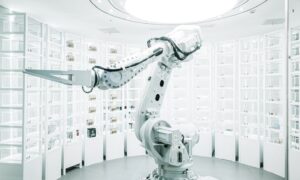Introduction:
Artificial Intelligence (AI) has emerged as a transformative force, reshaping industries, processes, and the very nature of work. As AI technologies continue to advance, their impact on employment is a topic of widespread discussion. This article delves into the challenges and opportunities that arise from the integration of AI into the workforce, exploring the dynamic relationship between technology and employment in the 21st century.
The Evolution of Work in the Age of AI:
The advent of AI technologies has ushered in a new era in the world of work. Automation, machine learning, and robotics are revolutionizing industries, streamlining processes, and augmenting human capabilities. While these advancements bring about increased efficiency and productivity, they also raise concerns about the potential displacement of jobs and the need for reskilling in the workforce.
Challenges:
Job Displacement:
As AI takes on routine and repetitive tasks, there is a concern that certain jobs may become obsolete. Industries relying heavily on manual or routine tasks, such as manufacturing and data entry, face the risk of significant job displacement. Workers in these sectors may find their roles automated, leading to the need for reemployment strategies.
Skill Mismatch:
The rapid evolution of AI technology often outpaces the skill sets of the existing workforce. There is a growing gap between the skills demanded by emerging technologies and the skills possessed by the workforce. This creates a challenge in aligning educational and training programs with the evolving demands of the job market.
Unequal Impact:
The impact of AI on employment is not uniform across all sectors and demographics. Certain industries may experience substantial job losses, while others witness job creation. Moreover, the impact varies based on factors such as geographical location, education levels, and socio-economic backgrounds, leading to potential inequalities in the workforce.
Opportunities:
Job Creation in AI-Related Fields:
While AI may lead to the automation of some jobs, it simultaneously creates opportunities in AI-related fields. The demand for data scientists, AI engineers, and machine learning specialists is on the rise. Upskilling the workforce to meet the requirements of these roles can result in a new wave of employment opportunities.
Enhanced Productivity and Efficiency:
AI technologies contribute to enhanced productivity and efficiency in various industries. Automation of routine tasks allows human workers to focus on more complex and creative aspects of their jobs. This shift can lead to the creation of higher-value jobs that require critical thinking, problem-solving, and emotional intelligence.
Innovation and Entrepreneurship:
The integration of AI fosters innovation and entrepreneurship. Small and medium-sized enterprises (SMEs) can leverage AI tools to streamline operations, reduce costs, and gain a competitive edge. This entrepreneurial spirit can lead to the creation of new businesses and job opportunities.
Human-AI Collaboration:
The future of work involves a collaborative partnership between humans and AI. While AI handles repetitive tasks and data analysis, humans contribute creativity, emotional intelligence, and complex problem-solving skills. This collaboration can result in more dynamic and adaptive workplaces.
Addressing the Challenges:
Investment in Education and Training:
To bridge the skill gap, there is a need for significant investment in education and training programs. Educational institutions, governments, and businesses must collaborate to develop curricula that align with the demands of the evolving job market. Lifelong learning initiatives can help workers adapt to the changing landscape.
Reskilling and Upskilling Programs:
Reskilling and upskilling programs are essential to empower the existing workforce with the skills needed for the jobs of the future. Companies can play a pivotal role in providing training opportunities for their employees, ensuring a smooth transition to AI-enabled workplaces.
Social Safety Nets:
Policymakers must establish robust social safety nets to support workers facing job displacement. This includes unemployment benefits, retraining assistance, and initiatives to facilitate career transitions. A comprehensive approach is necessary to mitigate the potential socio-economic impacts of AI-driven job changes.
Ethical AI Practices:
Organizations deploying AI technologies must prioritize ethical considerations. Transparent decision-making processes, accountability, and addressing biases in AI algorithms are crucial for building trust. Ensuring that AI technologies are developed and deployed ethically can contribute to a more inclusive and fair job market.
The Future of Work in the AI Era:
As we navigate the impact of AI on employment, it is crucial to envision a future where technology complements human capabilities rather than replacing them. The evolution of work in the AI era is likely to be characterized by a shift towards roles that require uniquely human skills – creativity, empathy, critical thinking, and adaptability.
Hybrid Workforce:
The future workforce is likely to be a hybrid of humans and machines, each playing to their strengths. AI will handle routine tasks, data analysis, and automation, while humans contribute the qualities that make them irreplaceable – innovation, emotional intelligence, and complex problem-solving.
Continuous Learning Culture:
A continuous learning culture will be integral to the future of work. Lifelong learning will become the norm as workers adapt to evolving technologies. Employers, educational institutions, and individuals must embrace a mindset of continual skill development to stay relevant in the dynamic job market.
Job Evolution, Not Extinction:
Rather than fearing job extinction, the focus should be on job evolution. While certain roles may become obsolete, new and more complex roles will emerge. Navigating this transition requires a proactive approach to education, training, and a commitment to fostering a workforce equipped for the challenges and opportunities of the AI era.
Conclusion:
The impact of Artificial Intelligence on employment is a multifaceted phenomenon that demands thoughtful consideration and proactive measures. While challenges such as job displacement and skill mismatches loom large, there are ample opportunities for innovation, job creation, and the cultivation of a more dynamic and adaptable workforce. By investing in education, prioritizing ethical AI practices, and fostering a culture of continuous learning, societies can navigate the evolving landscape of work in the AI era, ensuring that the benefits of technology are harnessed for the greater good.



































